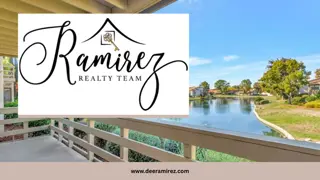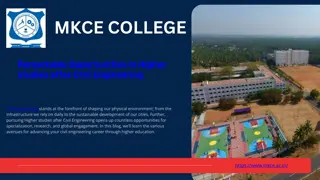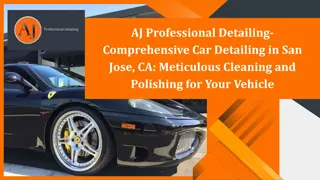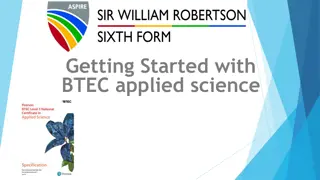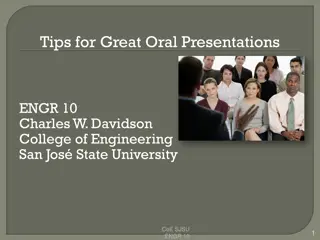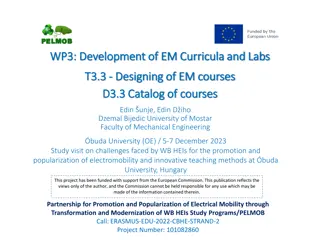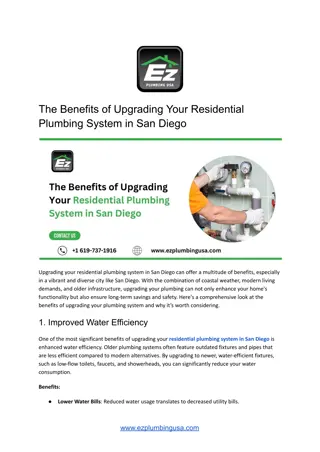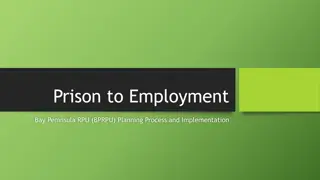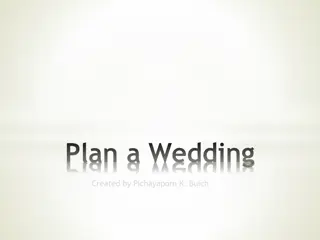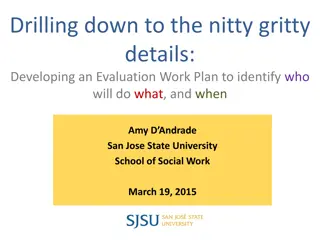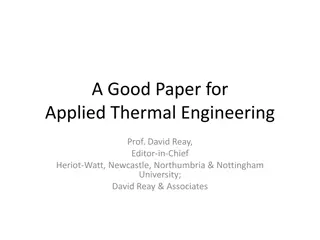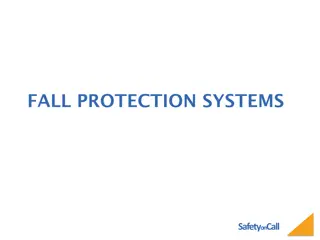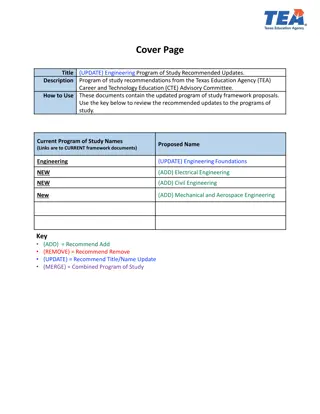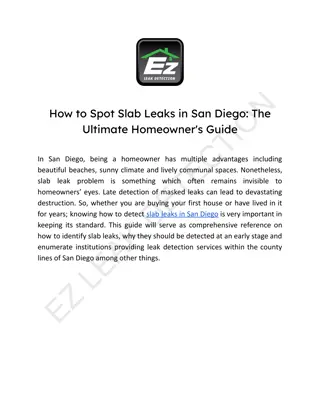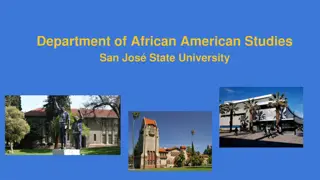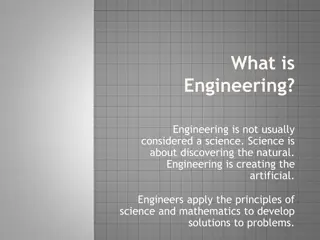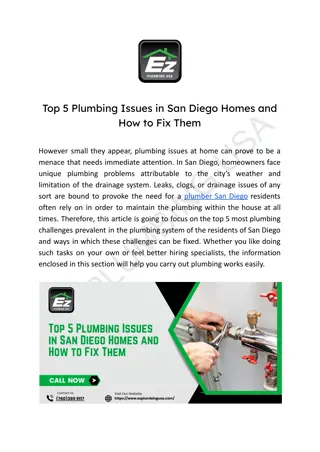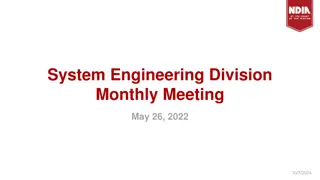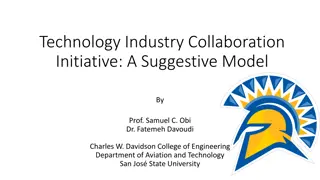ME 130 Applied Engineering Analysis Class Fall 2018 at San Jose State University
San Jose State University's Department of Mechanical and Aerospace Engineering offers the ME 130 Applied Engineering Analysis course in Fall 2018 instructed by Dr. Tai-Ran Hsu. Prerequisite math courses include pre-calculus, calculus, and differential equations. Students are expected to have a solid foundation in various mathematical topics to succeed in the course.
Download Presentation

Please find below an Image/Link to download the presentation.
The content on the website is provided AS IS for your information and personal use only. It may not be sold, licensed, or shared on other websites without obtaining consent from the author.If you encounter any issues during the download, it is possible that the publisher has removed the file from their server.
You are allowed to download the files provided on this website for personal or commercial use, subject to the condition that they are used lawfully. All files are the property of their respective owners.
The content on the website is provided AS IS for your information and personal use only. It may not be sold, licensed, or shared on other websites without obtaining consent from the author.
E N D
Presentation Transcript
Welcome to ME 130 Applied Engineering Analysis Class Fall 2018 Instructor: Tai-Ran Hsu Professor Department of Mechanical Engineering San Jose State University San Jose, California, USA Available @ links: www.engr.sjsu.edu/mae/faculty/hsu/index,htm www.engr.sjsu.edu/mae/greensheets/htm 1 ME 130 Greensheet F18/Green sheets
San Jose State University Department of Mechanical and Aerospace Engineering ME 130 Applied Engineering Analysis-1 Semester: Course Number: Fall 2018 46683 Prerequisites**: Co-requisites: ME 101 and ME 113 Math 133A with grad C- or better TR 09:00 10:15 AM E341, Engineering Building Class Hours: Class Room: Dr. Tai-Ran Hsu, E117B, Tel: 924-3905, E-mail: tai-ran.hsu@sjsu.edu Thursdays 1:00 3:00 PM, or by appointment Instructor: Office Hours: ** Students are expected to have learned the math subjects listed in the Table in the next slide. You are strongly encouraged to become familiar with those underlined topics. 2
**Prerequisite Math Courses for the Course on Applied Engineering Analysis SJSU Course No. and Title Math 19 Pre-Calculus Principal Course Syllabi Functions and graphics; Polynomial and rational functions; Exponential, logarithm and trigonometric functions; Analytic trigonometry; Applications of trigonometric functions; Polar coordinates and vectors; Analytic geometry; Systems of equations and inequalities Functions and continuity; Derivatives of polynomials, exponential, trigonometric, logarithm and hyperbolic functions; Maximum and minimum values; The mean value theorem; L'Hopital's rule; Newton's method-an introduction to anti differentiation Areas and distances; The definite integral; Areas between curves; Volumes; Volumes by washers and cylindrical shells; Work; Integration by parts; Arc length; Area of a surface of revolution; Sequences and Series; Power series; Complex numbers Curve defined by parametric equations; Areas and lengths in polar coordinates; 3-D coordinate systems; Vector algebra; Equations of lines and planes; Cylinders and quadric surfaces; Cylindrical and spherical coordinates; Vector functions and space curves; Derivatives and integrals of vector functions; Arc length; Motion in space; Functions of several variables; Partial derivatives. The chain rule; Lagrange multipliers; Double integrals over general regions; Applications of double integrals; surface area; Triple integrals in cylindrical and spherical coordinates Math 30 Calculus I Math 31 Calculus II Math 32 Calculus III Math 133A Differential Equations Solution of first order differential equations with application to falling body, terminal velocity; Solution to linear second order differential equations - homogeneous and non-homogeneous equations with applications to vibration of mass-spring systems; Laplace transforms; Series solutions of differential equations-Taylor series method, power series, analytic functions 3
Mathematics indeed will be the principal TOOL that we will be using in this course. But NOT this types of math that confuse everybody:! images of unsolvable equations images of unsolvable equations We will use the math that you have already learned in your 4 previous math courses in the Lower Division to do the following in this course: To enhance your learning of the following major sub-disciplines of mechanical engineering in: fluid mechanics (ME 111), heat transfer (ME 114), rigid body dynamics (ME 101), and machine design (CE 112, ME 147, 154, models for the engineering processes and systems for these sub-disciplines. Problems in these sub-disciplines will be the problems that you will be dealing with after you walk-out from this university and join the work force to be a valuable and versatile MECHANICAL ENGINEEERS!! ME 157, 160, 165) with Analytic 4
Course Description To pick up the right math and solve the math for your problems is NOT enough, you will also need to develop the knowledge and skill to get the: Practical interpretations of analytical and approximate solutions for steady and non-steady state mechanical engineering. In addition to the course syllabi that you learned from your Lower Division math courses (as in the Table in slide 3 shows), we will also need to learn the linear algebra and statistics and their applications in quality assurance in mass productions- to make you a more contemporary mechanical engineer. SO, THIS IS AN ENGINEERING COURSE NOT ANOTHER MATH COURSE A side note: I Am aware of one criticism by my class in the 2017 SOTE report: I spent too much time in presenting principles than I should have in offering more examples in the class. While I share this feeling by the student(s) who offered this criticism, and I wish we had enough time to do both, my reason for spending more time on principles over examples was solely because I want to educate you to be ENGINEERS but not TECHNICIANS. 5
Textbook:1)Bonded printed lecture notes on Applied Engineering Analysis, by Tai-Ran Hsu, San Jose State University, Spring 2018 (printed and sold at the Spartan Book Store) 2) Slides for class instructions (copies available in instructor s SJSU web page) References: 1) Applied Engineering Analysis by Tai-Ran Hsu, John Wiley & Sons, Feb 2018 (ISBN 978-1-119-07119-8). Prices: $104.99 (e-version), $130 hardcover. (see the cover picture below) 2) Avallone, Eugene A., Theodore Baumeister III and Alvan Sandegh, Marks Standard Handbook for Mechanical Engineers, 11th edition or newer, McGraw-Hill, 2006, ISBN 0071428674 3) CRC Standard Mathematical Tables, CRC Press, Inc., or similar mathematical and mechanical engineering handbooks. Intended for both ME 130 and ME 230 My latest book publication By John Wiley & Sons: 6
Grading Scheme: Homework: Mid-term exam*: Final examination: Bonus quizzes: 6% on TWO (2) take-home assignments on specific (see examples below) topics (may include building class demonstration units) by teams of 2 or 3 students on VOLUNTARY BASIS (marks will be based on satisfaction to the specific requirements of the assignments). *This date for the mid-term exam will be finalized on August 31, 2018 by the class - the last class date before voluntary withdrawal of this course. Answers (but not solutions) to homework problems are posted in the instructor s webpage. 25% (account for the Best of 5 from 6 assigned sets) 30% (Thursday, November 8, 2018)* 45% (Thursday, December 13, 2018, 07:15-9:30 AM Room E341) 4 Examples of Bonus quizzes related to engineering analysis: 1) 2) Crash of a DC 10 jumbo jet passenger plane over the Chicago O Hare airport on May 25th, 1979 as shown in the picture: 3) Experiment with the cooling of a small solid of known surface area (A) at an initial temperature (T0) to the desired lower temperature T in a cooling chamber at Tf. on Gas Pipeline burst in San Bruno, CA in September 2010? 4) Design and construct an experimental set-up for class demonstrations of resonant and near-resonant vibration of a solid mass supported by an elastic spring, 7
GRADING SYSTEM Letter grades will be assigned based on overall class performance, with Grade C+ or B- to be the median of the overall mark distribution of the class. 8
Important NOTE to the class: (1) There will be NO make-up mid-term and final examinations, except for students with serious medical reasons. A medical doctor s certificate is required to support such request. Request for make-up exams under this circumstance must be sent to the Instructor for approval within three days after the event. REASON for this stipulation is to be fair to the rest of the class. (2) In all open-book exams, only calculators, reference books and bonded printed notes are allowed but NOT notebook computers and any wireless phones or device. (3) Late submission of homework past the due dates and time will not be accepted. This stipulation is necessary in order to be fair to the rest of the class, which respects and abides by the assigned deadlines for submission. Students are encouraged to use on-line solution methods in their home works. However, they must indicate the precise website address from which they obtained these solution methods. The Grader will not give credits for homework solutions without such disclosures. (4) Students are encouraged to ask questions at all times in the classroom and during the assigned office hours. 9
It will be your responsibility to let the Instructor know if he did not answer your questions to your satisfaction. (5) In preparing for future professional practices, students are expected to be concise in answers to problems in home works and examinations. Some partial marks will be given to the examinations based on Examiner s judgment on student s comprehensions of the problems in the exams with incorrect answers In the spirit of fairness, the instructor will do his best in imposing uniform criteria in assigning partial marks to quizzes and exams with incorrect answers. Please refrain yourself from arguing for more generous allowance on the marks from the instructor for incorrect answers to problems in exams. (6) Class instructions will be handled exclusively by slide projections. Copies of the slides are posted in the instructor s webpage (7) Materials for quizzes and exams will include: (a) printed lecture notes (b) slide projections in class teaching, and (c) verbal presentations by the instructor. 10
Academic Integrity with Absolute ZERO TOLERANCE Students are expected to have read the University Policy, which is available at: http://www2.sjsu.edu/senate/S04-12.pdf Course Goals To learn the relationships between engineering (the master ) and mathematics (the servant ) and how they work together in solving engineering problems To learn how to derive mathematical (analytical) models for the solution of engineering problems To learn how to formulate mathematical models, e.g. calculus and differential equations for mechanical engineering problems involving various sub-disciplines To learn how to interpret mathematical solutions into engineering terms and senses 11
Student Learning Objectives To fully understand the physical (engineering) interpretations of fundamentals of mathematical terms such as variables, functions, differentiation and derivatives, integration, differential equations To acquire experience and skill in basic methodologies in differentiation, integration and solving ordinary and partial linear differential equations To be able to relate special tools such as Laplace transform and Fourier series for modeling engineering phenomena and facilitate the mathematical solutions To be able to establish mathematical models, such as differential equations and appropriate boundary and initial conditions for fundamental mechanical engineering problems in fluid mechanics, vibration and heat conduction of solids and find ways to solve these equations To be proficient in finding solutions of integrals and related information from tools such as mathematical handbooks, spreadsheets and computer software such as Mathcad and Matlab To learn the basic principles of linear algebra and statistics and their applications in engineering design analysis and productions 12
Instruction Schedule Focus: Math and physics (engineering): Week 1: Chapter 1: The basic principles of engineering analysis and its applications Week 2: Chapter 2: The principles and terms in mathematical modeling Focus: Application of 1st order DEs in fluid dynamics and heat transfer: Week 3: Chapter 3: Derivation and solutions of first order ordinary differential equations Week 4: Chapter 3: Application of first order ordinary differential equations in fluid mechanics, heat conduction in solids and kinematics of rigid body Focus: Application of 2nd order DEs in mechanical vibration analyses: Week 5: Chapter 4: Solution of homogeneous, second-order linear differential equations Week 6, 7: Chapter 4: Application of ordinary differential equations in mechanical vibration Focus: Useful tools for engineering analysis: Week 7, 8: Chapter 5: Laplace transform and its physical meaning, and applications Week 9: Chapter 6: Fourier series and its engineering applications Week 10: Chapter 7: Introduction to partial differential equations Week 11: Chapter 8: Linear algebra and its application in engineering analysis Week 12: Chapter 9: Introduction to finite difference method Focus: Application of statistics in quality control in mass productions: Week 13-15: Chapter 10: Introduction to statistics and applications to manufacturing process and quality control 13 NOTE: The above schedule may be modified as needed
It is my passion to educate you the best I can, but it is your responsibility to try hard to learn from me Attend all classes, and listen attentively to what the Instructor says in the lectures, If you: Do not hesitate to ask questions in the classes, or after the classes. and never pretend that you understand what is being said in the lectures but the matter of fact is that you did not. Do all homework problems if possible, and understand how they are done Make sure to let the Instructor know your problems in learning the various subjects of this class whenever they occur Make use of Instructor s office hours for questions and advice Form a study group with 2 or 3 favored fellow students in the same class to work on: exchange class notes, doing home works, review returned and exam papers, and exchange speculations on possible exam problems. Above all; take a proactive attitude of ENJOYING what you are learning from this course You will do well and be successful if you do all the above! 14
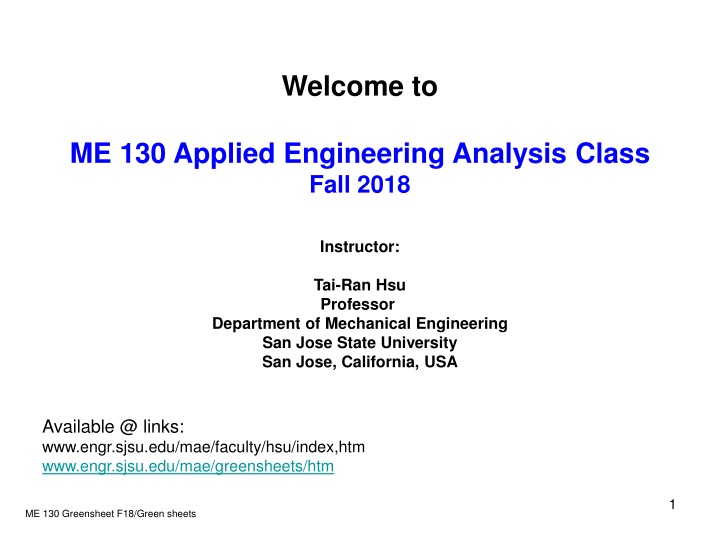

![(❤Read⚡) [✔PDF✔] The Best Travel Guide - San Diego: A Cicerone’s View of To](/thumb/68088/read-pdf-the-best-travel-guide-san-diego-a-cicerone-s-view-of-to.jpg)

